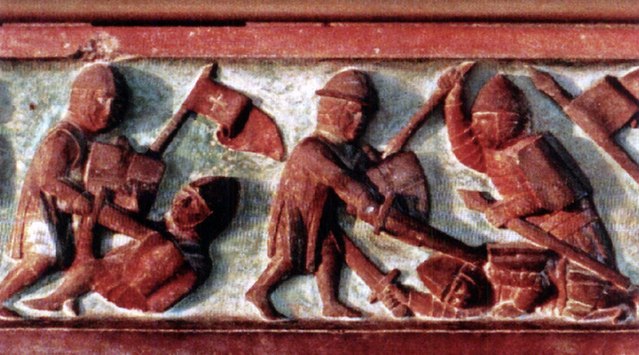The Grunwald Swords are a pair of simple bare swords sent as a mocking "gift" by Ulrich von Jungingen, the Grand Master of the Order of Teutonic Knights, to King Władysław II Jagiełło of Poland and Grand Duke Vytautas of Lithuania. The swords were sent on 15 July 1410, just before the Battle of Grunwald (Tannenberg), as a symbolic invitation to engage Jungingen's forces in battle. After the Polish–Lithuanian victory, both swords were taken as a war trophy by King Władysław II to Kraków, Poland's capital at the time, and placed in the treasury of the Royal Wawel Castle.
Two Swords by Wojciech Kossak (c. 1909). In this painting, the swords are being presented by members of the Teutonic Order, wearing their distinctive white cloaks, rather than by messengers bearing the heraldic devices described by Długosz.
The monument to King Władysław II Jagiełło in Central Park, New York City, United States, depicts him brandishing two swords in victory.
Between 1796 and 1830, the swords were kept in the Temple of the Sibyl at Puławy, the private museum of Princess Izabela Czartoryska (19th-century engraving).
1st class Order of the Cross of Grunwald
The Battle of Grunwald, Battle of Žalgiris, or First Battle of Tannenberg, was fought on 15 July 1410 during the Polish–Lithuanian–Teutonic War. The alliance of the Crown of the Kingdom of Poland and the Grand Duchy of Lithuania, led respectively by King Władysław II Jagiełło (Jogaila), and Grand Duke Vytautas, decisively defeated the German Teutonic Order, led by Grand Master Ulrich von Jungingen. Most of the Teutonic Order's leadership were killed or taken prisoner.
Battle of Grunwald by Jan Matejko (1878)
The most important source about the battle is Cronica conflictus...
Lithuanians fighting with Teutonic knights (14th-century bas-relief from the Malbork Castle)
Teutonic Order presents Grunwald Swords as gift to King Władysław II Jagiełło (painting by Wojciech Kossak)







